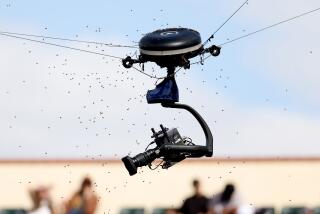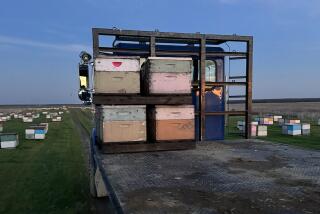A Stinging Rebuke to Technology : He Makes Hand-Crafted Bee Baskets for the Fun of It
- Share via
CARDIFF, Calif. — When God was distributing gifts to the animals the bees asked to be lodged in golden baskets and that their sting be always deadly so as to be respected therein. God, to chastise them for their arrogance, lodged them in straw skeps and caused that a bee should die whenever it stings. --A Christian fable
Rolla Chandler and his gentle craft of skep making have been stung rather badly by arrogant progress.
Combine harvesters, for example. They whack long-stemmed rye into bristles. Ancient threshers, on the other hand, would separate grain from supple stems that dried into straw and became the ideal weft of the traditional skep.
Sighed Chandler: “So I’m using cattails, Mexican fan palm, swamp grass, brook sedge, anything that’s available. . . .”
Home for Honeybees
Skeps house honeybees that produce a food. No matter that this Stone Age sweetener has been associated with good health since ancient Egyptians used it as an embalming fluid, government agriculturalists have long outlawed straw skeps. Or maybe, purists believe, it was an 1850 pine lumber lobby that created the legislation that ordered these wonderfully rustic straw bee hives replaced by gauche, institutional wood-sided bee boxes .
“In many states they’re illegal and California is one of them,” Chandler said. “They say that with a skep, you can’t inspect the comb for bee diseases unless you want to turn it upside down and that wouldn’t be very wise. Of course, I’ve never actually heard of diseased honey. . . .”
More laws. Woe betide the apiarist who violates local ordinances banning backyard boxes. Fortunately, there are no such bees in Chandler’s bonnet. “I’ve got four boxes three miles away on private land near the San Dieguito River. I pay rent to the owner. About three gallons of honey a year.”
As he spoke, youthful noises rolled over fences and around the rear of Chandler’s seaside home here. Rock music. Heavy, Ozzy Osbourne, nap-shattering, bee-stirring noise. Three miles might not be far enough.
On the other hand, there are definite advantages to being a quiet eccentric who hand-makes anachronisms of marginal usefulness. He is a symbol of opposition to manufacturers who push technology and utility over the sheer fun of stuff.
That’s why Chandler’s skeps are selling like hot honeycakes.
It used to be his hobby, Sunday afternoons, two hours here, 45 minutes there. Now Chandler is a one-man cottage industry pulling a six-day workweek.
Yesterday’s production was one skep a month. Now it’s three or four a week.
“Right now I’m back-ordered for eight large skeps and 12 small ones,” he said. That’s 83 hours labor right there. “The supply will always be limited. I don’t believe in grinding them out like some of your craftsman . . . by machine and bandsaw.”
Who is buying?
Eighteen states and Australia is all. There are Chandler skeps at the Cook County Forest Preserve in Illinois and at an historical settlement at Hermann, Mo.
Herbalists want skeps for their yards.
Olde Worlde Touch
They are being ordered for kitchens, dining rooms, hutches, health food stores, vegetarian restaurants, country schools and city greenhouses and this month, Chandler became the darling of all avant-garde gardeners:
He made the Smith & Hawken Catalog for Summer, 1986.
Smith & Hawken is the Fortnum & Mason of all things bright and beautiful, green and growing and olde worlde. It’s a retail store and mail-order house at Mill Valley that specializes in the best of the generally forgotten.
Such as Panama hats and 1885 watering cans by John Haws of London. Also thatched bird houses from Devon, poachers’ spades, Gloucester park benches, heather brooms . . . and now “Mr. Chandler’s skeps of rye straw and other native grasses depending on the season.”
Of course, skeps don’t come cheap. Chandler’s junior skeps (about 10 inches in height and diameter) are advertised for $44 apiece. The larger version (12 inches up and across) goes for $98 and that’s a lotta beeswax.
Supply limited, notes the catalogue.
“I’ve had people wait six or eight months for a skep,” he said. “They wait because they know it will be a labor of love. They’ll wait to enjoy the oldness and the imagery of it.”
Yet Chandler lives with a niggle of pessimism.
“We’re really only dealing with a basket here,” he explained. “I suspect that one of these days the Philippines or Taiwan will start making skeps and sending them over here for $10 a piece.”
Began in Missouri
Chandler, 58, a first-generation American of British parents, began beekeeping as a high school junior in Missouri. When Chandler went to Washington and the Bureau of Land Management (“land records, titles, leases, patents, that type of thing”), the bees buzzed along.
Then developed Chandler’s passion for all things colonial, pine furniture, pewter, trivets, and the countie faires of Maryland and the Virginias. He started selling honey. He sold honeycombs. He sold beeswax candles. But so did everyone else.
“I wanted to start doing something unusual, something that was still colonial but still attached to beekeeping,” Chandler said. “That was in 1981 and about 150 skeps ago.”
Chandler’s choice certainly was esoteric. There is no reference to skeps (medieval English for “basket” . . . it does not follow that a man who puts all his bees in one basket is known as a skeptic) in Encyclopedia Britannica. The National Agricultural Library has nothing on the subject.
Chandler’s research did turn up a brochure in England. Everything seemed pretty straightforward. “I just sat down and started doing it,” he remembered.
He played the Renaissance Fair and National Colonial Farm Day in Maryland. Then retirement, a move to California and skep weaving appearances from the Encinitas Arts and Crafts Fair to this month’s Marin County Fair.
He Is Not Alone
Surprisingly, Chandler is not alone in his ancient labor. He knows of another skeppist (“you can recognize his work . . . he uses a bigger coil to make a larger skep”) in Maryland. In Europe--home of real bread, homespun tweeds, Stilton cheese and similar enviables of life--there are skeps in daily use and constant manufacture because their health inspectors aren’t quite as eager to muck about with centuries of tradition.
When he’s not making skeps, Chandler is collecting skeps. That has made his home a small museum and his domestic role more guide than host.
“Here are two little English beehives, small, and you can see the soot inside made from when they used smoke to make the bees swarm.
“This is from Germany, this is from Holland and I think they make them there on some kind of mold because they are so tight. You can buy these Dutch skeps from a couple of suppliers, but you can’t buy an American one unless you write to me. Or to that man in Maryland.
“Do bees have a preference for skeps over bee boxes? None whatsoever. They will swarm and form a colony anywhere. In a jelly jar if that’s where you put them.”
When Ambrose was just another 4th-Century Italian bambino, a swarm of honeybees settled on his cradle. They came in peace. He survived unstung. Ambrose went on to become Bishop of Milan . . . and, somewhat less significantly, the patron saint of beekeepers.
They still make a Dutch skep in the image of St. Ambrose. Much more ceremonial than practical, an Ambrosius Hive is a tall, woven cleric complete with miter, pectoral cross, jug ears and crosier.
Skeps have been considered symbolic of perfect social orders and, as such, an industrial-political inspiration for the medieval Catholic church, Napoleon’s armies and Brigham Young. Hence Utah the Beehive State and skeps as emblems for 150 Utah businesses and organizations.
Other Uses
And the American skep lives as fireplugs, honey pots, doorknobs, clocks, gravestones, cakes, Jell-O molds, highway markers, pop bottles, newel posts, several dozen souvenirs of Salt Lake City . . . almost everything, in fact, except working beehives.
As a gesture to such history, Chandler always dresses his part. The shoes are buckled clodhoppers. At state fairs and county days he weaves in a tricorn hat and colonial blouse bought at Williamsburg. His wife made the buttoned knee pants.
That little piece of tailoring, however, is the limit of Jean Chandler’s involvement in her husband’s product and pastime.
“She’s very allergic to dust and straw,” Chandler said.






